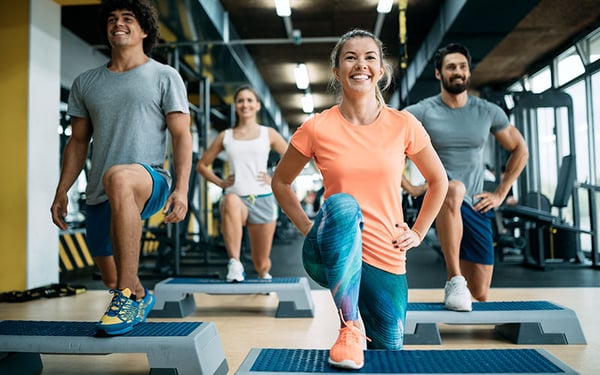
No Group Fitness Instructor sets out with the intention of hurting or injuring participants. Most get into the profession to help and connect others to their fitness goals.
But sometimes, we Group Fitness Instructors can harm our participants' bodies, even with the best intentions. How is this happening?
Let's explore strategies for successfully and safely cueing your group fitness participants below.
The Importance of Anatomy for Group Fitness Cues
Bodies change, our participants change, exercises have changed. Our society has become seated, in the sagittal plane. Many of us sit at a desk for most of the day, sit in a car for a long commute, or spend hours hunched over our devices, causing all-new movement concerns.
The body's anterior muscles are becoming shorter and weaker, where the posterior longer, and yes, more fragile. Concerns also arise from new exercises and formats, recent fitness trends, and quick fixes that can lead to repetitive movement injuries and bone alignment dysfunction.
While many consider the study of anatomy a dead science, meaning we know all about our bodies' anatomy we can, the rumors of its demise are greatly exaggerated. As long as fitness professionals create new content and new cues, we need to continually reassess to ensure we are keeping the entire group of participants in mind.
Safe And Appropriate Cues
We must frequently turn back to the AFAA five questions.
- What is the purpose?
- Is it effective?
- Is it safe?
- Can I maintain the movement?
- Who is the exercise appropriate for?
Let's address the last two questions, safety, and appropriateness.
Some exercises that we teach are perfectly safe for specific participants, but they can cause a severe injury to others. Group fitness is best when it is all-inclusive and appropriate for as many individuals as possible.
We want our 60-year-old mother, our 40-year-old cousin, and our 20 something neighbor to participate in the same class and be safe.
This is why, as Group Fitness Instructors, we have to ditch the exclusive cues, cues that are exclusive just directed at certain participants, and change them to inclusive cues.
Thereby answering the last two questions, "yes, it is safe, and it is appropriate for almost everyone."
(1) Exclusive Cue to Modify: Rolling One Vertebra at a Time
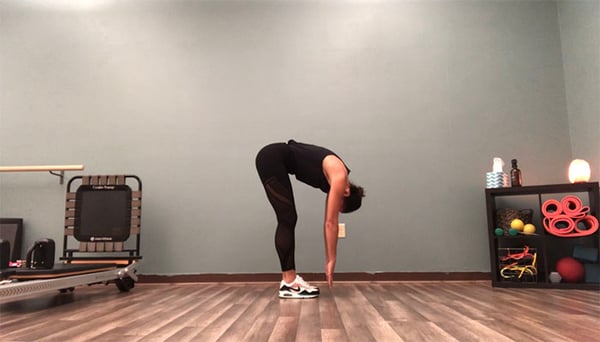
What makes rolling one vertebra at a time exclusive?
The risk to the spine makes this an exclusive cue. As the body hangs in a forward fold flexion of the spine, the upper body's entire weight relies upon the vertebrae doing the least amount of flexion, or at that folding point. Vertebrae are designed to work as a team, with the support of the core muscles.
As participants roll up one at a time, all the upper body weight pulls on the one vertebrae or the connection point between two as they stack and be straight. This puts an overwhelming amount of pressure on individual disks. This can cause a bulging disk or a slipped disk on bodies.
A participant with a strong core can use the core muscles to assist in this process, but can you guarantee all of your participants have a strong core?
Use This Inclusive Cue Instead: Raise Spine to Halfway Position

Raise the spine to halfway, press your palms into your shins or thighs. Engage the core, rise up hinging from the hips.
(2) Exclusive Cue to Modify: Going to Deep on Push-up and Chaturanga
Bottom out the push-up, drop your chest to the floor, then lift back up.
Or.
Dive the chin to the floor in chaturanga.
What makes this exclusive?
You can damage the rotator cuff or shoulder. The head of the arm bone within the shoulder is wrapped with the rotator cuff muscle group. The rotator cuff’s job is to rotate the humerus bone within the shoulder socket. When a push-up or chaturanga is dropped to the floor, many rotator cuff muscles become stabilizers for that action. The cuff muscle’s job is not to stabilize; it is to rotate.
They can even be forced to take a large amount of bodyweight to support the action. This can cause tears in the superior muscle or attachments of the shoulder cuff. A participant with strong shoulders, chest, and core with perfect alignment can handle this action, but can your guarantee all of your participants have strong shoulders, chest, and core and have ideal alignment?
Inclusive Cue for Safer Movements: Achieve a Right Angle with Arm
Lower into your push up or chaturanga until the arm reaches a right angle, or the upper arm bone is parallel to the floor, then press back up.
(3) Exclusive Cue to Modify: Low Squat Depth

First position squat or plié, bring your heels together, turn your toes out, and plié squat, as low as you can go.
What makes this exclusive?
The knees push beyond the toes, causing overstretching of ligaments and tendons in the knees and damage to the meniscus. We have learned from the beginning that in a squat, the proper form is to line the knees up with the second toe and then only squat as low as we can maintain the knees staying behind the toes.
Then the new fitness trend of Barre came along. Here the practice is to take the first ballet position and squat as low as we can. With no meniscus damage, young knees and all their articular cartilage covering the bones can handle this move, but others may be injured. The knee bones may rub against each other without lubrication, tendons and ligaments may stretch and become damaged.
A participant with flexible leg muscles and thick undamaged meniscus can handle this exercise, but can you guarantee all your participants have the knees of a teenager?
Inclusive Cue for Safer Movements: Use Your Toes!
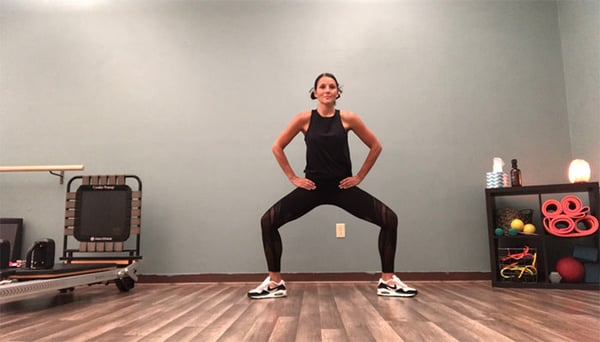
Take your legs hip-distance apart, turn the toes out and lower down as far as you can and still see your toes beyond your knees.
(4) Exclusive Cue: Putting Back Knee Down During Lunge
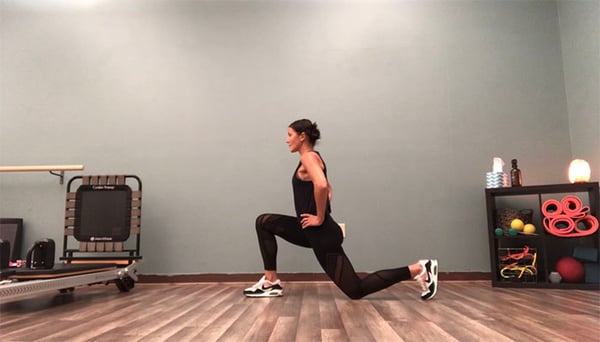
Put your back knee down on the floor in a lunge.
What makes this exclusive?
The hip flexor may be too tight to allow the knee to go to the floor; the participant may arch the back to make up the difference. These days, most bodies are in a seated position for many hours, causing hip flexor muscles to shorten, tighten, and weaken.
When doing a lunge, the back leg hip flexor is pretty tight. To lunge with proper alignment for the knees, many participants need to separate the legs a considerable distance. This means when the cue to bring the knee to the floor is added on, the tight hip flexor or iliopsoas muscles pull on the low back creating an unsafe backbend. This can lead to low back pain or injury.
A participant with flexible hip flexors can handle this exercise, but can you guarantee all your participants have flexible hip flexors?
Inclusive Cue for Safer Movements: Maintain Proper Knee Alignment
In a lunge, lower your back knee as low to the floor to maintain a straight spine and proper knee alignment.
(5) Exclusive Cue: Turn Knees and Toes Out During Jumping Jack
While doing a jumping jack, turn the knees and toes out.
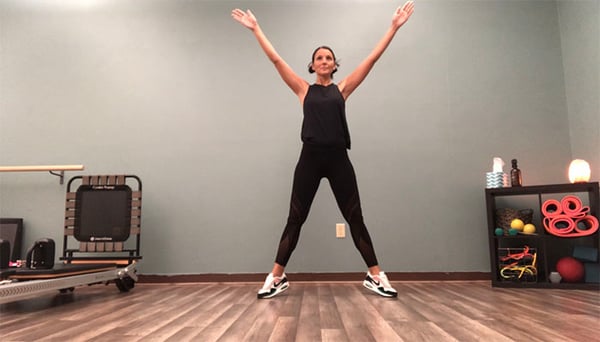
Why is this exclusive?
It does not allow for day-to-day alignment and can cause tighter external rotators and weaker internal rotators. This is a cue that has just come about recently, and the intention behind it was to create a "safer" jumping jack. One of the common misalignments of a jumping jack comes from weak ankles or feet sickling in.
So if the legs are externally rotated during the jumping jack, the feet don't have as far to travel. On the surface, this seems like a great solution.
Instead of strengthening the ankles and focusing on their alignment, this cue has created a cheat. If done often enough, the external rotator or deep-six muscles between the hip and femur begins to strengthen and tighten, while the internal rotators are stretched and weakened.
The result is a constant external rotation or leg turn out. A participant who balances out their jumping jacks with internal rotation exercises can do jacks turned out all they want, but can you guarantee to teach internal rotation, or guarantee participants will do internal rotation exercises at home independently?
Inclusive Cue to Apply: Keep Leg Movement Natural
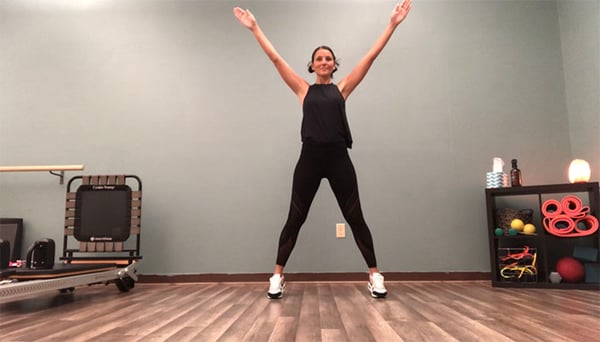
Keep the ankles healthy, in line with the knees, and only move the legs out as fast and far as you can maintain proper alignment.
Group Fitness instructors have no idea what body types, strengths, and conditions will walk into their class at any given time. There is no guarantee with experience, alignment, and strength with our participants. If we had time to individually access each participant and then create a plan for each, that would be a different story.
That would be personal training. Group fitness instructors choose group training because of the energy and community the group provides. The best practice for group fitness is to teach the moves appropriate for the entire group with the safest common denominator in mind. Keep the moves and the cues inclusive.

